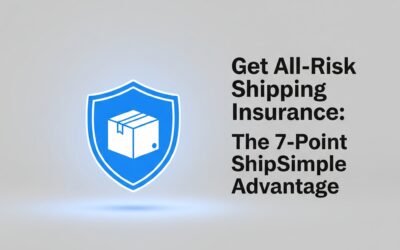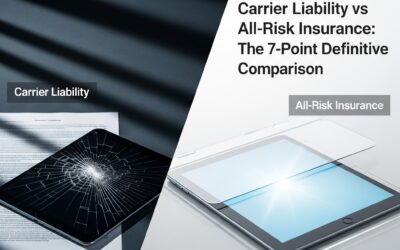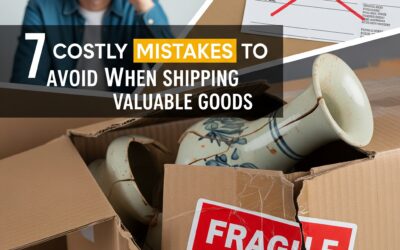How to Safeguard Your Valuable Shipments from Start to Finish
In today’s fast-paced shipping landscape, knowing how to safeguard your valuable shipments is no longer optional — it’s essential. Whether you’re shipping a luxury watch, irreplaceable artwork, or fragile electronics, one wrong move can cost you thousands. From loss to damage and theft, the risks are real. That’s why smart shippers are investing in proven strategies to protect their parcels at every stage of the journey.
To effectively safeguard your valuable shipments, you must think beyond the basics. Standard carrier protections often fall short, especially for high-value or one-of-a-kind items. Implementing professional-grade packaging, choosing reputable carriers, and adding the right insurance are all part of a comprehensive defense strategy. But it doesn’t stop there — proactive steps like using tracking tools, signature confirmation, and discreet labeling can make the difference between peace of mind and a costly claim.
Whether you’re a jewelry retailer, tech brand, or just sending a special gift, your goal is the same: ensure safe, on-time delivery with zero surprises. This guide breaks down the key steps to safeguard your valuable shipments, minimize risk, and elevate your shipping standards — so every delivery arrives intact, insured, and secure.

What Can Cause Harm To Your Valuable Shipments?
When you’re shipping valuable shipments, you’re not just moving parcels — you’re entrusting the safety of high-value, often irreplaceable items to a complex system of logistics, handlers, and transit points. Understanding the risks involved is not only smart — it’s essential. From environmental extremes to simple human oversight, the threats are real and numerous. Let’s take a deep dive into the most common causes of harm to your valuable shipments and how you can proactively safeguard them.
Environmental Conditions: The Silent Threat
Environmental damage is one of the most underestimated risks in the shipping world. Valuable shipments, particularly those containing sensitive items like electronics, pharmaceuticals, cosmetics, or gourmet foods, are vulnerable to temperature fluctuations, humidity, and exposure to moisture.
For example, a vintage wine bottle shipped without climate control can easily become undrinkable. High humidity can ruin documents, artwork, or leather goods. Cold temperatures may freeze and crack glass items, while heat can warp vinyl records or melt cosmetics. If your valuable shipments are exposed to these environmental extremes — especially during long international journeys — the damage might be irreversible.
Solutions include thermal packaging, desiccant packs, and choosing carriers that offer temperature-controlled logistics. Recognizing the environmental needs of your specific shipment can make the difference between safe delivery and total loss.
Packaging Errors: Your First Line of Defense
Another major risk factor is poor or insufficient packaging. Packaging is not just a formality — it’s your first and strongest line of defense against rough handling, falls, compression, and vibration. Yet, many individuals and businesses still use one-size-fits-all boxes, inadequate padding, or substandard tape.
If you’re shipping fragile goods like pottery, lab equipment, or crystal, your packaging must absorb shock and distribute pressure evenly. Valuable shipments benefit greatly from multi-layer protection: double-boxing, foam inserts, and custom-fitted containers.
Incorrect labeling is also a packaging issue that can cause severe delays. A mislabeled “Fragile” box might be stacked under 100 pounds of steel parts, rendering your carefully packaged item useless.
Don’t cut corners. Invest in high-quality materials, train staff on proper packaging techniques, and consider third-party packaging services for especially valuable shipments.
Human Error: The Most Common Risk
Human error can take many forms — mistyped addresses, incorrect item descriptions, misrouted shipments, or even forgotten labels. These mistakes may seem small, but they can result in lost or severely delayed valuable shipments.
One common scenario: a wrong apartment number means a package is marked “delivered” but ends up with the wrong recipient or is stolen from a doorstep. Businesses risk not only the item’s value but also their brand reputation when such errors occur.
The best defense is process automation. Double-check all labels before printing. Use barcode scanning, automated address validation tools, and consider tracking services that offer real-time updates. For business owners, standardizing your shipping process can drastically reduce these common but costly mistakes.
Theft and Tampering: A Growing Concern
With the rise of e-commerce, porch piracy and in-transit theft have grown at an alarming rate. Packages left on doorsteps, in mailrooms, or unmonitored storage areas are at risk. If your valuable shipments contain electronics, jewelry, or branded merchandise, they are especially attractive targets.
Shipping insurance can help recover financial losses, but it’s no substitute for prevention. Signature-required delivery, discreet packaging, and secure drop-off locations (like lockers or concierge desks) can greatly reduce your risk.
Tampering during customs or at distribution centers is also a real concern. Using tamper-evident seals, RFID tags, or smart sensors can help track access to your shipment and alert you to unauthorized handling.
Carrier Mistakes and System Breakdowns
Even the most trusted courier services occasionally make mistakes. Packages are scanned incorrectly, lost in transit, or delivered to the wrong address — especially during peak holiday seasons or major sales events. Your valuable shipments could be delayed for days or weeks, or even vanish without a trace.
If your package isn’t properly insured, you could be left with little or no recourse. Many standard shipping policies offer limited coverage, and the claims process can be slow or restrictive.
This is where third-party shipping insurance comes in. Companies like ShipSimple specialize in insuring high-value items with fast claims processing and broader coverage terms than standard carriers.
Customs and International Delays
When shipping across borders, your valuable shipments face additional scrutiny. Customs officials may open and inspect packages, which increases the risk of mishandling. Inconsistent repackaging, missing documentation, or non-compliance with import/export regulations can cause significant delays.
To minimize risk, ensure your commercial invoices are complete and accurate. Use a customs broker if you frequently ship internationally, and always verify that your insurance covers international destinations.
Also, clearly labeling your shipments with “Do Not Open” or “Handle with Care” in multiple languages can reduce confusion during customs checks.
Inadequate Insurance Coverage
Many people assume that basic carrier insurance is sufficient, but this is rarely the case — especially when it comes to valuable shipments. Most standard policies cap compensation at a few hundred dollars, far below the value of items like high-end fashion, medical equipment, or custom-made goods.
Worse still, these policies often have tight restrictions, such as excluding fragile goods or requiring extensive documentation to prove value. In the event of a dispute, you may end up wasting weeks chasing a partial reimbursement.
Third-party insurance providers offer more flexible, comprehensive coverage for a wider range of goods. They also tend to be faster and easier to work with when it comes to claims, making them the preferred choice for businesses shipping high-value items regularly.
Knowledge is Protection
Every time you send a package, you’re relying on a complex, interconnected web of systems to get it where it needs to go — intact and on time. The more valuable your shipments are, the higher the stakes. Damage, theft, delays, or loss can mean more than just inconvenience — they can mean financial loss, a damaged reputation, or even legal issues.
Understanding the threats that face your valuable shipments — from environmental exposure and human error to theft and customs complications — gives you the insight needed to make smarter shipping decisions. Don’t leave things to chance. Take the extra steps to pack intelligently, choose the right partners, insure properly, and track every step of the journey.
When you know what can go wrong, you’re far better prepared to make sure everything goes right.
How to Safeguard Your Valuable Shipments?
When it comes to eCommerce, luxury retail, or sensitive B2B logistics, the need to safeguard your valuable shipments is non-negotiable. Whether you’re shipping high-end electronics, medical supplies, rare artwork, or sensitive documents, the risks are real—and preventable. With supply chains growing more complex and global, understanding how to proactively protect your valuable shipments can save your business from profit loss, reputation damage, and unhappy customers.
This comprehensive guide outlines step-by-step best practices to safeguard your valuable shipments every time they leave your hands.
Choose the Right Packaging for Valuable Shipments
Packaging is your first and most critical defense line when aiming to safeguard valuable shipments. Skimping here is a fast track to financial loss.
- Use double-wall corrugated boxes for heavier or more fragile goods.
- Add foam inserts, bubble wrap, or custom-molded supports to prevent internal shifting.
- Double-box high-value items—one box cushioned inside another.
- Avoid reusing old boxes with compromised structure.
Use materials designed specifically for the item being shipped. For example, sensitive electronics should be sealed in anti-static bags, while fragile glass items benefit from shock-absorbing foam molds. Pro tip: Add “FRAGILE,” “HANDLE WITH CARE,” or “THIS SIDE UP” stickers to guide handlers. While this isn’t foolproof, it can reduce careless stacking or compression.
Pro tip: Add “FRAGILE,” “HANDLE WITH CARE,” or “THIS SIDE UP” stickers to guide handlers. While this isn’t foolproof, it can reduce careless stacking or compression.
Label Accurately and Legibly
Mislabeling is a common and costly mistake. To truly safeguard your valuable shipments, ensure all shipping labels are:
- Legible and scannable
- Accurately filled out, with sender and receiver contact info
- Correctly placed on the largest side of the box (not across seams)
Include a duplicate label inside the box, in case the outer one gets damaged or falls off. This small step can be the difference between a delayed package and a permanently lost one.
Invest in High-Value Shipping Insurance
Even with the best packaging and labeling, accidents happen. That’s why one of the most important steps to safeguard your valuable shipments is purchasing the right shipping insurance.
Relying solely on courier-provided insurance is risky. Their coverage is often limited to $100–$500 and may exclude many valuable shipment types (like collectibles, jewelry, or perishables). Worse, their claims process can be complex and slow.
Third-party shipping insurance providers like ShipSimple offer:
- Higher coverage limits
- Broader coverage terms
- Faster claims resolution
- Options for both domestic and international shipping
 Always declare the full value of the shipment and save receipts or invoices in case you need to file a claim.
Always declare the full value of the shipment and save receipts or invoices in case you need to file a claim.
Use Tracking and Real-Time Monitoring Tools
Tracking isn’t just for customer convenience—it’s an essential part of your strategy to safeguard valuable shipments. Real-time tracking helps you:
- Monitor delivery status
- Detect reroutes or suspicious delays
- Identify theft or loss early
For high-value or sensitive shipments, go further with GPS-enabled sensors, RFID tags, or IoT-enabled smart packaging. These tools offer live location updates, detect temperature fluctuations, and alert you to tampering.
Major benefits:
- Instant notifications of delays or route deviations
- Tamper alerts if packaging is opened
- Environmental monitoring (temperature/humidity)
This level of visibility provides peace of mind and offers crucial proof if things go wrong.
5. Choose Reliable Carriers and Secure Delivery Methods
Not all shipping companies are created equal. Some have higher damage and loss rates than others. Research carrier reputations, delivery guarantees, and insurance policies.
When shipping valuable items:
- Opt for carriers with strong tracking infrastructure
- Use signature-required delivery
- Choose overnight or 2-day shipping to minimize handling time
- Avoid peak shipping days when warehouses are overwhelmed
 Pro tip: Consider white-glove or bonded courier services for ultra-valuable shipments. These services offer personalized handling, extra security, and sometimes even climate-controlled delivery.
Pro tip: Consider white-glove or bonded courier services for ultra-valuable shipments. These services offer personalized handling, extra security, and sometimes even climate-controlled delivery.
Secure Internal Contents
Even within a sealed package, the contents need protection. Loose items can shift, collide, and break. To safeguard your valuable shipments, ensure:
- Items are immobilized using padding or dividers
- Liquids are sealed in leak-proof containers and double-bagged
- Sharp items are capped, wrapped, or boxed
Add a packing list or invoice inside the box, not just for reference, but to help with insurance claims and customs processing.
Plan for Environmental Challenges
Environmental factors can silently destroy valuable shipments. Heat, cold, moisture, and pressure all pose risks.
Examples:
- Art and electronics can warp in high heat
- Pharmaceuticals may become inactive in extreme cold
- Moisture-sensitive items like documents or fabrics can mold
Solutions include:
- Thermal-insulated packaging
- Dry ice or gel packs
- Water-resistant containers or wrapping
- Humidity absorbers or silica gel packets
Check weather conditions along the transit route, especially for international deliveries. Work with carriers who offer climate-controlled transit if needed.
Prepare for Customs and International Risk
When shipping abroad, additional complications arise—especially if you’re moving valuable shipments across borders. Customs delays, repackaging, and regulatory restrictions can all lead to damage or loss.
To minimize issues:
- Use a customs broker for complicated shipments
- Provide complete and accurate documentation (invoice, HS codes, certificates)
- Know which items are restricted or prohibited
- Choose international insurance that covers destination risks
Avoid vague descriptions like “gift” or “merchandise.” Be specific and transparent to ensure smooth passage and reduce the risk of manual inspection.
Train Your Team and Audit Your Process
Whether you’re a small business or large enterprise, your ability to safeguard valuable shipments is only as strong as your weakest link.
- Train staff in packaging, labeling, and compliance best practices
- Create checklists for packing, insurance, and carrier selection
- Audit your shipping process monthly to identify risks or inefficiencies
Consistency and discipline are key. The more standardized your processes, the lower the chances of human error.
Offer Safe Delivery Options for Recipients
Lastly, your customer experience doesn’t end when the shipment leaves your facility. To protect the last mile of delivery:
- Provide delivery windows or scheduled drop-offs
- Offer pickup lockers or concierge services
- Allow signature-required or adult-only delivery
- Use discreet packaging to avoid advertising the contents
Even the most carefully shipped package can be stolen if left on a doorstep. Encourage your customers to use tracking and be available at delivery time.
Final Thoughts
Learning how to safeguard your valuable shipments isn’t just about logistics—it’s about responsibility, trust, and customer experience. In a world of rising theft, increasing costs, and customer expectations for perfection, protecting what you ship is vital to your business’s reputation and bottom line.
By mastering the key strategies above—secure packaging, insurance, tracking, environmental protection, and team training—you can confidently ship high-value goods knowing they’ll arrive safely. Whether you’re an individual sending a one-time valuable item or a business with daily luxury shipments, these practices are essential to success.
Don’t leave your valuable shipments to chance—safeguard them like your business depends on it. Because it does.
Extra Steps For High Value Shipments
Ensuring your products arrive at their destination in perfect condition is paramount. Here’s how proper packaging and additional shipping measures can achieve this:
The Power of Proper Packaging
- A Protective Shield
Effective packaging acts as a barrier, safeguarding your products from potential damage during shipping. Sturdy cardboard boxes provide a robust foundation, while cushioning materials like bubble wrap and foam padding absorb shocks and impacts that could occur in transit.
- Minimizing Damage
This cushioning significantly reduces the risk of breakage, scratches, or dents caused by rough handling or items shifting within the package.
- Secure Closures
Proper packaging goes beyond just the box. Securely sealing the package with strong packing tape prevents it from opening or sustaining damage during handling and transportation.
By selecting appropriate packaging materials and techniques, businesses can effectively minimize their products’ vulnerability to various shipping hazards. This not only protects the products themselves but also reduces the likelihood of costly returns or replacements.
Enhanced Protection with Tracking and Insurance
Beyond the physical protection of packaging, tracking and insurance offer additional layers of security during shipping:
- Real-Time Visibility
Tracking allows businesses to monitor the package’s journey in real-time. This transparency fosters confidence as they can anticipate any delays or issues and take proactive measures if needed, ensuring the safe arrival of the shipment.
- Peace of Mind with Insurance
Insurance serves as a financial safety net in case of unforeseen events such as theft, loss, or damage during transit. Purchasing shipping insurance helps businesses mitigate the financial risk associated with shipping valuable or fragile items. In the event of any mishaps, they are adequately compensated, safeguarding against potential financial losses and providing peace of mind for both the shipper and the recipient.
By implementing these practices, businesses can significantly enhance the security of their products during shipping, leading to a smoother customer experience and a more successful operation.
Conclusion
No matter what you’re shipping, the stakes are high. Choosing to safeguard your valuable shipments isn’t just about preventing loss — it’s about preserving trust, brand reputation, and customer satisfaction. With rising e-commerce volume and increased risk of theft and mishandling, there’s no room for shortcuts. By applying these best practices, you’re not only protecting items — you’re protecting your bottom line.
Remember, the decision to safeguard your valuable shipments doesn’t have to be complicated. Start with high-quality packaging, secure labeling, and end-to-end tracking. Layer in the right insurance coverage, preferably through a provider that understands high-value shipping. Then, fine-tune your process by verifying delivery addresses, requiring signatures, and avoiding red-flag shipping times like holidays or weekends.
By following the steps outlined in this guide, you’ll create a shipping system built for resilience, reliability, and real-world performance. Whether you’re a seasoned shipper or new to logistics, learning how to safeguard your valuable shipments is one of the smartest business moves you can make in 2024 — and it starts with intentional action today.
FAQ’s
1. What does it mean to safeguard your valuable shipments?
Safeguarding your shipments means protecting them from risks such as loss, damage, or theft through careful packaging, reliable carriers, insurance, and tracking.
2. What type of insurance is best for valuable shipments?
Third-party shipping insurance is often the best option, as it offers broader coverage and fewer exclusions than standard carrier insurance.
3. How can I discreetly label valuable shipments?
Avoid using words like “jewelry” or “electronics” on the label. Instead, use generic business names or nondescript product names to avoid drawing attention.
4. Is signature confirmation necessary?
Yes. Signature confirmation helps ensure the item was received by the correct person and can reduce the risk of theft or “porch piracy.”
5. Can I get insurance if I use my own courier account?
Yes. Many standalone providers allow you to purchase insurance even when you use your own courier or account.
6. What’s the best packaging for fragile items?
Use double boxing, foam inserts, bubble wrap, and reinforced corners. Always test packaging for impact resistance.
7. How can I track high-value shipments?
Use advanced tracking tools offered by couriers or third-party platforms that provide real-time alerts and delivery updates.
8. When is the best time to ship valuable items?
Avoid weekends and holidays. Early weekday shipments with 1-2 day delivery windows offer better predictability and less risk.
Additional Resources
- Consumer Reports – How to Ship Valuables Safely
- Forbes – Shipping Tips for Small Businesses
- Better Business Bureau – Protecting Shipments
- U.S. Postal Inspection Service – Prevent Mail Theft
- Entrepreneur – Logistics Management for E-commerce
- Insurance Information Institute – Shipping Insurance Explained
- Smithsonian – Packaging and Transporting Fragile Items
- Small Business Administration – Shipping Resources





